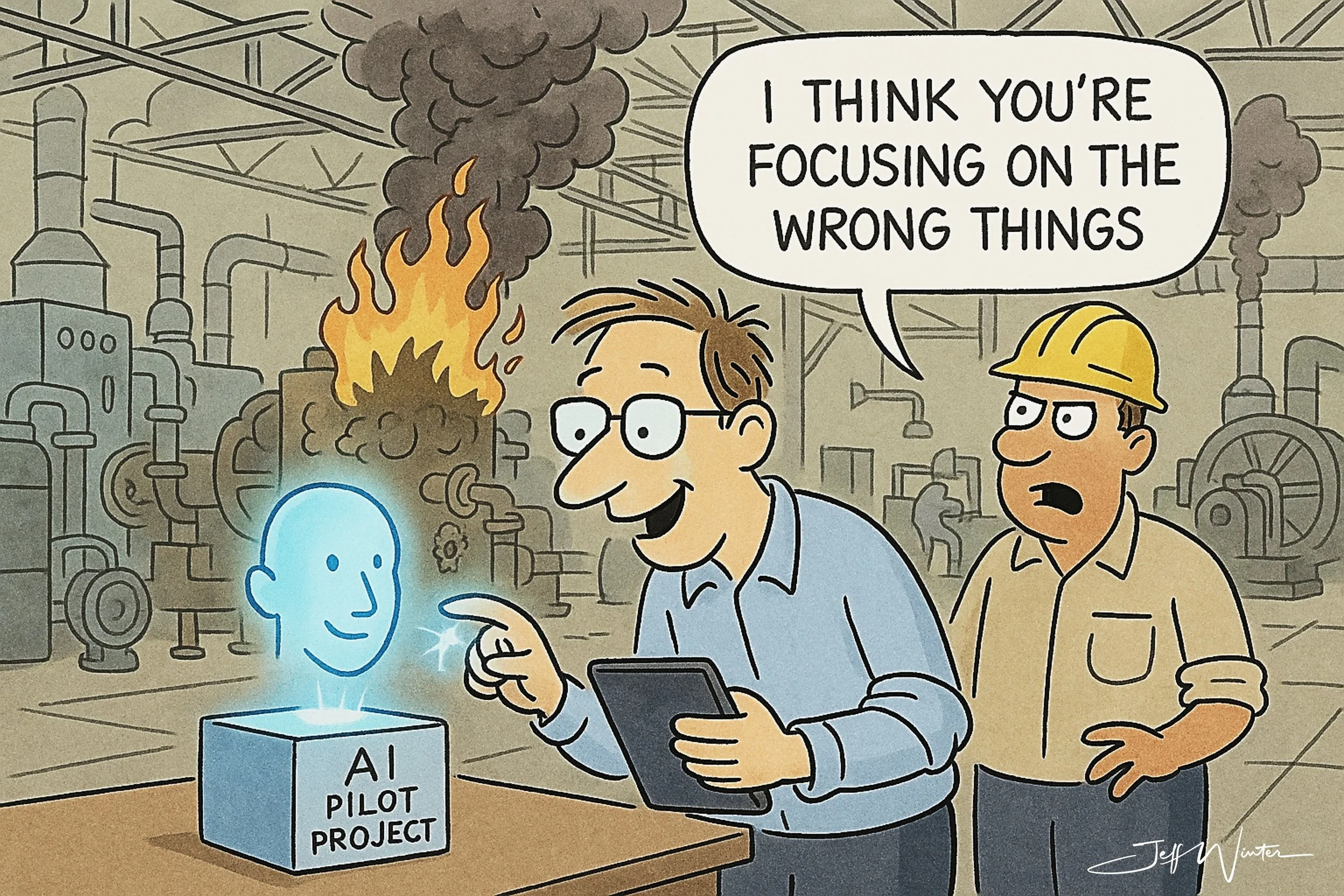The Art, and Risk, of Misplaced Priorities in the Age of AI
Some companies are masters at setting priorities… just not the right ones.
I’ve walked into plants where the production line is literally on fire (or at least metaphorically smoldering)…
…and yet, the leadership team is in a conference room debating which AI pilot project to run next.
It’s not that the conversation about AI is unimportant. In fact, it’s crucial. But there’s a hard truth we need to face: technology can only accelerate what already works. If your core operations are broken, AI will just help you fail faster.
When the Basics Are Broken
Every leader loves to talk about innovation. Cutting-edge initiatives make for great headlines, investor pitches, and conference soundbites. But what’s not as glamorous is ensuring that your day-to-day operations are rock solid.
I’ve seen this play out countless times:
Safety incidents are quietly stacking up.
Machines are being held together with duct tape and hope.
Quality issues are bleeding margin on every shift.
Employee morale is circling the drain.
And yet, leadership is busy drafting proposals for “AI-powered predictive optimization dashboards” when they can’t even trust the accuracy of the data feeding their current reports.
Rule of Thumb: If you can’t keep the lights on, keep your people safe, and deliver consistent quality today, you’re not ready for tomorrow’s advanced tech, no matter how many pilots you run.
A Fun Way to Think About It
Picture your business as a house. You’re proud of it. You’ve worked hard on it. But right now, there’s a leaky roof, the wiring’s a little questionable, and the basement smells funny.
Now imagine you decide to install a $50,000 smart home automation system with voice-controlled lights, AI-driven climate control, and robot vacuum fleets. Sure, the tech is cool—but you’re still going to have rain pouring in on your smart TV, the power cutting out mid-movie, and a funky basement smell that no amount of AI can fix.
Or think of it like making an ice cream sundae. The “fundamentals” are your ice cream—smooth, solid, dependable. AI is the hot fudge and sprinkles. Without the ice cream, all you’ve got is a sad puddle of chocolate on the counter.
Moral of the story? Get the basics right first, so the fancy stuff actually makes life better instead of making the problems more high-tech.
Why AI Doesn’t Magically Fix a Broken Culture
AI has the potential to change manufacturing in profound ways. From predictive maintenance to supply chain forecasting, its applications can generate real value. But it can’t replace leadership discipline, operational excellence, or the trust of your workforce.
Think about it like this:
If you have a culture where problems are hidden, processes are undocumented, and decision-making is purely reactive, AI isn’t going to suddenly make people more accountable or transparent. What it will do is expose flaws faster, create new dependencies, and possibly overwhelm your teams with complexity they can’t handle.
You can’t automate your way out of a leadership problem. And you can’t apply cutting-edge tech to a foundation that’s crumbling.
The companies that win with AI aren’t the ones chasing the coolest proofs-of-concept. They’re the ones that start by nailing the basics, so that every investment in technology compounds rather than collapses.
The Priority Hierarchy That Actually Works
From years of walking shop floors, sitting in boardrooms, and watching initiatives succeed or implode, here’s the simple progression I’ve seen work:
Stabilize the Core
Fix critical safety, quality, and reliability issues first.
Make sure your processes are documented, repeatable, and measurable.
Strengthen the Culture
Build a culture of continuous improvement, not firefighting.
Encourage transparency and make problem-solving a shared responsibility.
Modernize the Foundation
Upgrade systems, clean your data, and integrate your operations.
Make sure your tech stack supports—not hinders—your people.
Targeted Innovation
Apply advanced tech like AI to the areas that already work.
Use it to accelerate impact, not to patch holes.
The Problem With Skipping Steps
When companies skip the foundational work, AI adoption becomes a distraction rather than a driver. They pour resources into flashy projects that don’t scale, can’t be trusted, or never make it past the pilot stage.
Worse, they erode trust within their own teams. Employees see leadership spending big on innovation while ignoring the problems they face every day. That sends a message—whether intentional or not—that the people keeping the lights on are less important than the tech meant to replace them.
And here’s the kicker: when those AI pilots inevitably fail to deliver, leadership often concludes, “AI doesn’t work here.” That’s not true. AI didn’t fail—the company’s priorities did.
Instead of asking, “Which AI project should we run next?”, the question should be:
“Where can technology amplify what we’re already great at?”
That reframes AI from being a savior to being an accelerator. It forces leaders to look in the mirror and be honest about their readiness. It turns technology investment into a force multiplier rather than a costly distraction.

